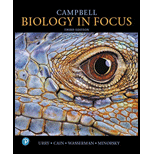
CAMPBELL BIOLOGY IN FOCUS-W/MASTR.BIO.
3rd Edition
ISBN: 9780134875040
Author: Urry
Publisher: PEARSON
expand_more
expand_more
format_list_bulleted
Concept explainers
Textbook Question
Chapter 5, Problem 5TYU
Which of the following processes includes all the others?
- A. osmosis
- B. diffusion of a solute across a membrane
- C. passive transport
- D. transport of an ion down its
electrochemical gradient
Expert Solution & Answer
Want to see the full answer?
Check out a sample textbook solution
Students have asked these similar questions
Green Algae, as a group, is actually paraphyletic with one subgroup more closely related to higher plants than the other. Which of the following green algae groups is more closely related to higher plants:
a. Charophyceans
b. Chlorophyceans
c. Rhodophyta
d. Xanthophyceans
A single-celled green algal genus that is motile with 2 flagella, has a cup shaped chloroplast, and an eyespot:
a. Volvox
b. Chlamydomonas
c. Euglena
d. Codium
A[n] ___ is produced by members of the Myxomycota when there is a lack of moisture.
a. plasmodiocarp
b. aethalium
c. sclerotium
d. plasmodium
Chapter 5 Solutions
CAMPBELL BIOLOGY IN FOCUS-W/MASTR.BIO.
Ch. 5.1 - Plasma membrane proteins have carbohydrates...Ch. 5.1 - WHAT IF? How would the membrane lipid composition...Ch. 5.2 - What property allows O2 and CO2, to cross a lipid...Ch. 5.2 - Why is a transport protein needed to move many...Ch. 5.2 - MAKE CONNECTIONS Aquaporins exclude passage of...Ch. 5.3 - How do you think a cell performing cellular...Ch. 5.3 - WHAT IF? If a Paramecium caudatum cell swims from...Ch. 5.4 - Sodium-potassium pumps help nerve cells establish...Ch. 5.4 - Prob. 2CCCh. 5.4 - MAKE CONNECTIONS Review the characteristics of the...
Ch. 5.5 - As a cell grows, its plasma membrane expands. Does...Ch. 5.5 - Prob. 2CCCh. 5.5 - MAKE CONNECTIONS In Concept 4.7, you learned that...Ch. 5.6 - During an epinephrine-initiated signal in liver...Ch. 5.6 - When a signal transduction pathway involves a...Ch. 5.6 - WHAT IF? How can a target cells response to a...Ch. 5 - In what way do the membranes of a eukaryotic cell...Ch. 5 - Which of the following factors would tend to...Ch. 5 - Phosphorylation cascades involving a series of...Ch. 5 - Lipid-soluble signaling molecules, such as...Ch. 5 - Which of the following processes includes all the...Ch. 5 - Based on Figure 5.17.which of these experimental...Ch. 5 - Prob. 7TYUCh. 5 - SCIENCE, TECHNOLOGY, AND SOCIETY Extensive...Ch. 5 - FOCUS ON EVOLUTION Paramecium and other...Ch. 5 - FOCUS ON INTERACTIONS A human pancreatic cell...Ch. 5 - SYNTHESIZE YOUR KNOWLEDGE In the supermarket,...
Additional Science Textbook Solutions
Find more solutions based on key concepts
True or false? Some trails are considered vestigial because they existed long ago.
Biological Science (6th Edition)
Determine [OH], [H+], and the pH of each of the following solutions. a. 1.0 M KCl b. 1.0 M KC2H3O2
Chemistry
Single penny tossed 20 times and counting heads and tails: Probability (prediction): _______/20 heads ________/...
Laboratory Manual For Human Anatomy & Physiology
How does the removal of hydrogen atoms from nutrient molecules result in a loss of energy from the nutrient mol...
SEELEY'S ANATOMY+PHYSIOLOGY
An obese 55-year-old woman consults her physician about minor chest pains during exercise. Explain the physicia...
Biology: Life on Earth with Physiology (11th Edition)
Knowledge Booster
Learn more about
Need a deep-dive on the concept behind this application? Look no further. Learn more about this topic, biology and related others by exploring similar questions and additional content below.Similar questions
- Which of the following is not true about the life-cycle of Fucus. a. 8 eggs per oogonium b. 64 sperm per antheridium c. eggs are flagellated d. sperm are flagellatedarrow_forwardGreen Algae, as a group, is actually paraphyletic with one subgroup more closely related to higher plants than the other. Which of the following green algae groups is more closely related to higher plants: a. Charophyceans b. Chlorophyceans c. Rhodophyta d. Xanthophyceansarrow_forwardCertain toxic terpenoids in this group is thought to deter herbivory but may also have some anti-tumor activity? a. green algae b. brown algae c. red algae d. golden algae e. none of thesearrow_forward
- In the cellular slime molds, the most common phase is: a. plasmodium b. pseudoplasmodial c. single cells as myxamoebae d. moundingarrow_forwardWhich of the following descriptive terms does not describe Hydrodictyon? a. colonial b. nonmotile c. 1 large reticulated chloroplast in each cell d. all of these describe Hydrodictyonarrow_forwardWhich of the following does not apply to Chara? a. "stoneworts" b. isogamous c. calcified walls d. apical growth with an axis and branchesarrow_forward
arrow_back_ios
SEE MORE QUESTIONS
arrow_forward_ios
Recommended textbooks for you
 Human Physiology: From Cells to Systems (MindTap ...BiologyISBN:9781285866932Author:Lauralee SherwoodPublisher:Cengage Learning
Human Physiology: From Cells to Systems (MindTap ...BiologyISBN:9781285866932Author:Lauralee SherwoodPublisher:Cengage Learning Human Biology (MindTap Course List)BiologyISBN:9781305112100Author:Cecie Starr, Beverly McMillanPublisher:Cengage Learning
Human Biology (MindTap Course List)BiologyISBN:9781305112100Author:Cecie Starr, Beverly McMillanPublisher:Cengage Learning Concepts of BiologyBiologyISBN:9781938168116Author:Samantha Fowler, Rebecca Roush, James WisePublisher:OpenStax College
Concepts of BiologyBiologyISBN:9781938168116Author:Samantha Fowler, Rebecca Roush, James WisePublisher:OpenStax College Biology Today and Tomorrow without Physiology (Mi...BiologyISBN:9781305117396Author:Cecie Starr, Christine Evers, Lisa StarrPublisher:Cengage Learning
Biology Today and Tomorrow without Physiology (Mi...BiologyISBN:9781305117396Author:Cecie Starr, Christine Evers, Lisa StarrPublisher:Cengage Learning


Human Physiology: From Cells to Systems (MindTap ...
Biology
ISBN:9781285866932
Author:Lauralee Sherwood
Publisher:Cengage Learning

Human Biology (MindTap Course List)
Biology
ISBN:9781305112100
Author:Cecie Starr, Beverly McMillan
Publisher:Cengage Learning

Concepts of Biology
Biology
ISBN:9781938168116
Author:Samantha Fowler, Rebecca Roush, James Wise
Publisher:OpenStax College

Biology Today and Tomorrow without Physiology (Mi...
Biology
ISBN:9781305117396
Author:Cecie Starr, Christine Evers, Lisa Starr
Publisher:Cengage Learning

The Cell Membrane; Author: The Organic Chemistry Tutor;https://www.youtube.com/watch?v=AsffT7XIXbA;License: Standard youtube license